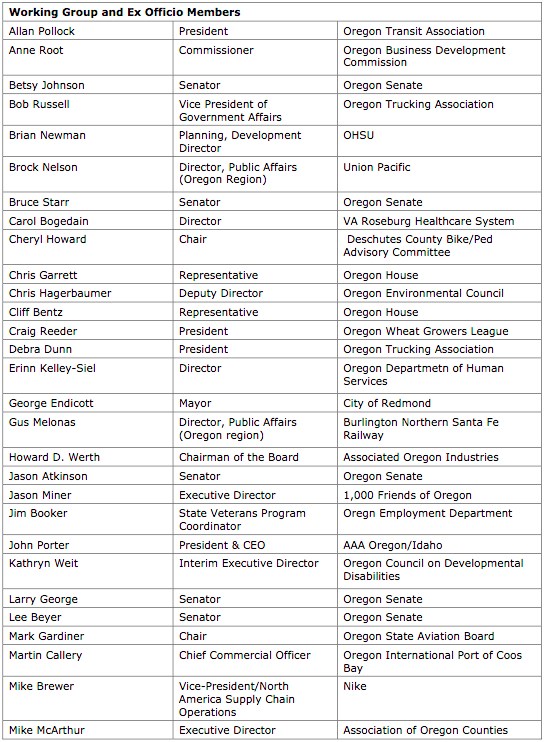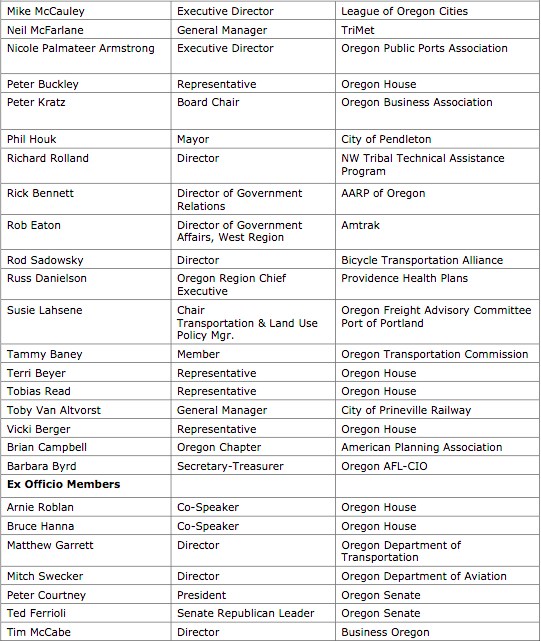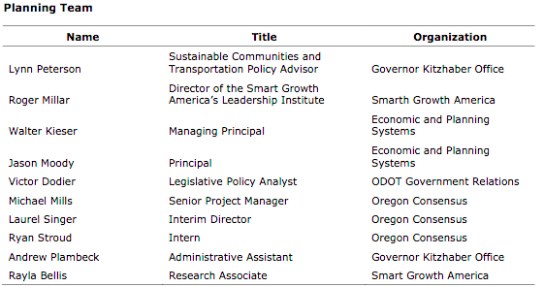
A new report presented to Oregon Governor John Kitzhaber yesterday outlines and prioritizes 16 new “non-roadway” transportation funding mechanisms. Among the ideas selected as a priority for “additional consideration for further implementation” and possible legislative action, is a “User fee for bikes.”
The 93 page report, Oregon Non-Roadway Transportation Funding Options: Report to the Governor, (PDF) is the result of a 64-person “Non-Roadway Working Group” that was convened by Kitzhaber back in November. The group included a large list of transportation stakeholders (including Bicycle Transportation Alliance Advocacy Director Gerik Kransky), many members of the Oregon legislature, and State staffers (see full list below).
The purpose of this project (which has been on the to-do list for the state since 2008) was to, “develop recommendations for sustainable funding of non-roadway transportation, including rail, marine, aviation, transit, and on and off-road bicycle and pedestrian paths.”
“We think it’s ridiculous for the state to consider putting a barrier between people and their bikes. We’re really upset. We argued strongly against it… It doesn’t belong on there. It doesn’t make sense.”
Gerik Kranksy, Bicycle Transportation Alliance Advocacy Director
In Oregon, there is an extreme lack of funding available for anything other than traditional, auto-centric highway and bridge projects. There are several reasons for this problem, with the largest being that our state constitution mandates that gas tax can only be used for projects within the highway right-of-way. Oregon also lacks a sales tax. Throw in a recession and better gas mileage in cars and you see how the money is scarce.
To help fill this funding gap — which they’ve pegged at about $550 million annually (or about 1/3 of the total annual gap) — the working group brainstormed 60 revenue-generating ideas. They then whittled that list down to just 16. Along with a the “user fee for bikes”, some of the other funding ideas they’ve chosen to prioritize include: expanded Lottery revenue, an expanded cigarette tax, expanded or new utility franchise fees, a new hotel/motel tax, use of the State Infrastructure Bank, and so on.
What didn’t make the prioritized list? A modification or expansion of the state gas tax, a congestion charge, weight mile fees, a VMT tax, and so on. (Keep in mind, this exercise only considered funding mechanisms to be used for “non-roadway” transportation modes.)
Just to be clear, here’s the expanded definition of “user fee for bikes” from the report:
Tax on bicycle operation or purchase dedicated to non-roadway transportation (e.g. bicycle license tax). Potentially voluntary with membership advantages
While finding new revenue streams to fund transportation in Oregon is crucial, this report raises a lot of questions. Who was on the Working Group? Why are “on-road bicycle facilities” (and not just dedicated “bicycle paths”) included in a discussion about “non-roadway” transportation modes? Why — despite its implementation challenges, failures in the past, and relatively low yield potential — is a fee on bikes and/or the people who ride them, still being seriously considered by Oregon leaders?
The make-up of the stakeholder group included only one representative to speak up for bicycle transportation. The BTA’s Gerik Kransky attended all the meetings. He said on the day the priority list was voted on, he “argued vociferously against” a bike users fee, but that in the end, he was simply outvoted.
“There were a lot of rail, port, freight, and marine advocates around the table… Then there was one bike advocate. There was no walking advocate. We were one vote out of 60.”
Kransky does not mince words in expressing his disappointment about this:
“We [the BTA] think it’s ridiculous for the state to consider putting a barrier between people and their bikes. The inclusion of a bike user fee on this list, flies in the face of the knowledge that we know bicycling provides benefits to our communities. We’re really upset. We argued strongly against it… It doesn’t belong on there. It doesn’t make sense.”
Kransky also correctly points out that various bicycle licensing and taxing schemes have never penciled out financially, once administrative costs are taken into account. The working group seemed to understand a bike user fee wouldn’t return much in the way of funds. The report itself states, “previous efforts have not even covered program administrative costs.” The report also noted the potential difficulty of enforcing a bike fee.
The few comments from working group members about a bike user fee that are shared in the report are also revealing:
Costs to run would be more than income generated.
Has been shown to not pay for itself. How about sales tax on bicycle equipment.
Oregon Legislative Fiscal Office analyzed this issue in the 2007 Legislature in HB 3008 and determined it would cost more to administer than it would return in revenue.
There is very little money here, we would require a great deal more information to move forward with this as a legitimate finance option.
Should do all we can to encourage carbon free transport options.
Tax on purchase is fine, on use is insignificant.
The costs to administer such a fee would outweigh the revenues.
This is long over due.
There is also concern that the annual funding gap for “Bicycle/Pedestrian Programs” has been significantly under-estimated. The report lists the total, statewide annual funding gap for bicycle and pedestrian investments as being a paltry $7.8 million. Expert sources I’ve heard from point out that this is a very misleading number. In the Portland region alone, one expert told me the annual bicycle and pedestrian project funding gap is $30 million per year.
Then there’s the “non-roadway” issue. I first heard this new term being used by ODOT Director Matt Garrett during our interview back in April. ODOT is using this term as a label for modes that do not rely on the public right-of-way — a.k.a. our roads and highways. “Bicycle facilities” can and should be built on public roads and ODOT should be very careful about attaching the term “non-roadway” to “bicycle facilities”. In a state where bicycles are considered vehicles with the full legal right to be on all public roads (minus most a few urban interstates), I feel this new term is a slippery slope to disrespect for a legitimate travel mode.
In the end, it’s clear that the idea of generating state revenue from the use or purchase of bicycles remains a potent one among Oregon politicians and policymakers. Kransky says the BTA will watch the upcoming legislative session closely to make sure any bike user fee bill does not move forward. Even so, my gut tells me we haven’t heard the last of it.
Stay tuned for more reporting on these topics.
— Download the full report here.
UPDATE: I just spoke with Governor Kitzhaber’s transportation policy advisor (and former Chair of Clackamas County) Lynn Peterson. Peterson said that the user fee for bikes, as prioritized in this report, is merely “a placeholder to acknowledge that we need to find a way to pay for bicycle infrastructure.” “It was duly noted in the committee that this wasn’t the best way to fund bike infrastructure, but there really wasn’t anything else on the table… It’s just the beginning of the discussion,” she said.
Here is the full list of Working Group members and project planning staff (note: Kransky is not on the list, but I have confirmed that he, not Rob Sadowsky, was present and active in the process):




